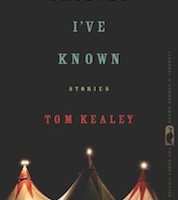Thieves I’ve Known, Tom Kealey’s debut story collection, charts a gothic landscape which is sometimes made literal as fantasy, and sometimes ripples the stories’ realist surfaces as parable. It is by turns as surreal as a dream and as visceral as a boxer’s swift uppercut, the debut of a wise, measured fictional voice. Kealey’s meticulously crafted stories resonate with empathy and insight.
In Kealey’s world, which extends from Pamlico Bay in North Carolina to Puget Sound, we encounter a pair of altar boys who journey to the underworld (possibly) to save (or damn) an old priest, by rescuing his boots. We meet a brother and sister – Merrill and Nate – who walk through a graveyard, then a run-down neighborhood, making up stories about the people in the houses. We meet a paraplegic, alcoholic veteran of the first Gulf war, and his brother, both of them haunted by their mother’s mental illness. The figure of a mother – absent, mentally or physically ill – haunts many stories, often appearing in moments of horror, as in the one when Phillip, a teenager, sees his mother, who is incarcerated, and whom he and his girlfriend, Shelby, have completed an arduous, rain-soaked journey to visit:
Phillip stood as a woman was wheeled through the door in a chair. Her skin was pale and gray, her eyes sunk in lines of wrinkles and brows, and one of her legs had been amputated at the knee. Her red pant leg was tied in a knot below. She pointed at their table, and the tall guard wheeled her over, set a brace against the rubber tire, edged back through the door, observing the other prisoners.
The power of this moment arises because it is unexpected – we assume that Phillip’s mother is relatively young, since he is a teenager – and also because it erupts into a quiet, seemingly good-natured story about a boy and a girl. No explanation is given, or reaction noted, on the part of Shelby, in whose point of view we remain for most of the story. This starkness makes the mother’s appearance, her unremitting hostility, all the more startling. Yet Kealey, here as elsewhere, records his characters’ movements with a calm, steady eye, a kind of intense open-heartedness, this steadiness and open-heartedness reflected in the calm, plain-spoken surface of the stories’ prose.
In the story from which the quote above is taken, “From Bremerton,” Phillip crafts origami, a nervous habit, we understand, but also a way to connect with other characters. At least, this is what we assume it to mean, our only insight into his mind a brief foray into his point of view where we learn about his obsession with aliens – an obsession, we already understand, to be both a means of escape and a way to contact the life around him that “might not be there at all.” Shelby’s attachment to Phillip, to their journey, to her own future, are contingent, as well: “[H]er love for the boy, her grades in school, her future, or what she hoped would be her future – were in doubt.” Yet she goes along with him, they call in a favor from Otis, her sister’s boyfriend’s friend, and they get to the prison. The story ends on the image of a paper frog Phillip has made, and a small but crucial act of charity.
 Such acts of imagination and kindness – of empathy as imagination – are what bind Kealey’s characters together, and make possible the stories’ moments of grace. In “Groundskeeping,” a young man, scarred and made cynical by his father’s death and mother’s institutionalization, finds respect for his uncle’s “work” of rigging minor league baseball games, and respect for his own “groundskeeping” of tending a garden, in the face of painful loss. A similar relationship between Shelby, seen at a later age, and Grimsley, a night watchman, arises in “The Problem of Flight.” In “The Lost Brother,” the story of the Gulf war veteran, Merrill ministers to both brothers during a night of drinking which takes the shape of a complex ceremony of renunciation, loss, and mutual support between the characters.
Such acts of imagination and kindness – of empathy as imagination – are what bind Kealey’s characters together, and make possible the stories’ moments of grace. In “Groundskeeping,” a young man, scarred and made cynical by his father’s death and mother’s institutionalization, finds respect for his uncle’s “work” of rigging minor league baseball games, and respect for his own “groundskeeping” of tending a garden, in the face of painful loss. A similar relationship between Shelby, seen at a later age, and Grimsley, a night watchman, arises in “The Problem of Flight.” In “The Lost Brother,” the story of the Gulf war veteran, Merrill ministers to both brothers during a night of drinking which takes the shape of a complex ceremony of renunciation, loss, and mutual support between the characters.
Throughout the collection, even in its most surreal stories, Kealey almost never loses a feeling for the manners of his characters’ lives, many of whom belong to our nation’s “underclass” (a pejorative term which is perhaps made literal in the boys’ journey to recover the priest’s boots). He is minutely observant of the social mores of his working-class characters, the ever-present necessity to earn one’s keep, the constant, pressing desire to escape. As fantastical as his stories can sometimes become, they are acutely conscious of the constraints of their characters’ lives, and within these constraints, the stories’ most complete moral visions are born. The characters in such stories as “The Lost Brother,” “Groundskeeping,” and “The Problem of Flight” live and breathe, and their dilemmas are at once particular and universal.
There is also humor. The title story contains an unforgettable, low-speed car chase between a cop and an elderly African-American grandfather and grandson. The mysterious plot of “The Boots” is counterbalanced by the boys’ arch dialogue – in many of the stories, the dialogue sparks with dry, tight-lipped wit. In almost all of the stories, there are moments of kindness and gentle humor that stand against the forces of madness and loss, which appear through the figure of the mother in “From Bremerton” or in extraordinary images such as this one from “The Lost Brother,” of a scarecrow with a “face of corn” created by their mother, as described by the narrator’s brother:
She had this box for a head. The scarecrow I mean. It was just a couple of sticks and some old clothes, and the box for a head, and Ma spent all night at the table, gluing this corn to the box. She made the eyes and a mouth. I don’t know. She just put the corn all over the head. Different shades of corn…. The birds came and ate all the corn off. It was gone by the afternoon. There was so many of them, the ripped the box right off the sticks. You could see them out there fighting over the head.
Against such images of loss, and of the loss incurred in trying to recover what is irredeemable, are moments of creative transcendence, as when Nate and Merrill imagine the lives of strangers in the houses, or when a boy in the title story imagines himself as “a boy on the other side of the river.” Such moments are there in Phillip and Shelby’s journey to visit Phillip’s mother, the boys’ journey to recover the priest’s boots – in every story in this impressive collection.
Tom Kealey’s debut introduces us to a world, and a fictional voice, which points us toward our better selves, without evading our dark side. We are lucky to have him, and to have the opportunity to hear more stories from him in the future.




